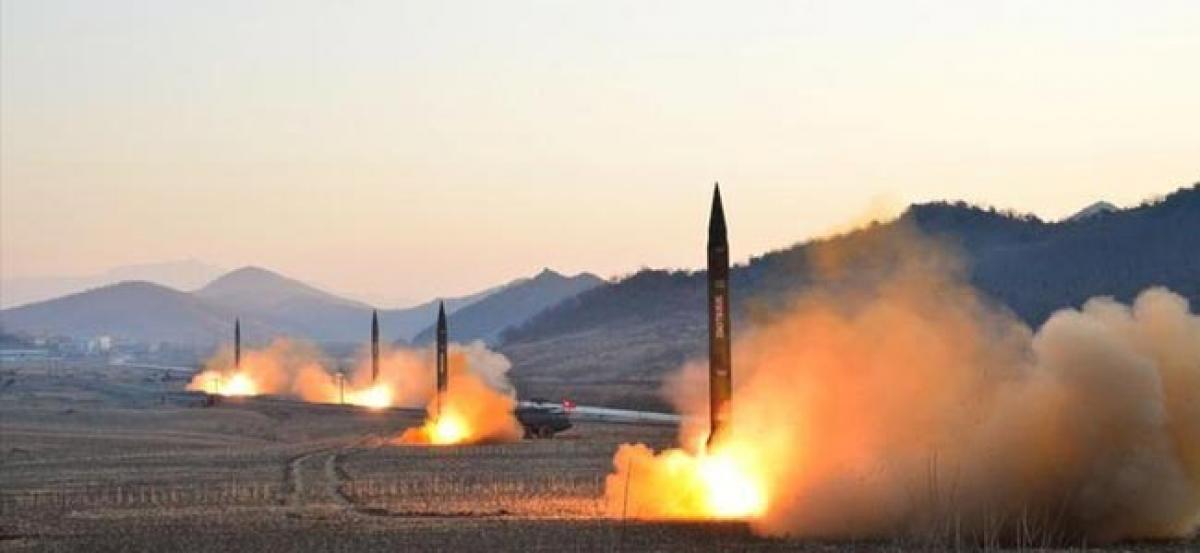Live
- Learned a lot from India's G20 experience, admits Brazilian President in meeting with PM Modi
- Santosh Trophy 2024: Rampant 8-0 win over Andhra Pradesh take Tamil Nadu to final rounds
- India producing 330 mn tonnes food grains, generating $50 bn in exports: Agriculture Minister
- On eve of Palakkad bypoll, CPI-M courts trouble over advertisement in Muslim newspapers
- Chelsea condemn homophobic abuse aimed at Sam Kerr after pregnancy announcement
- BGT 2024-25: Surinder Khanna urges India to draw inspiration from past wins
- AFC Asian FIFA WC Qualifiers: Japan score hat-trick of headers in 3-1 win over China PR
- Qatar says Hamas political office in Doha not permanently closed
- PM KISAN beneficiaries in Bihar’s Nalanda draw benefits of scheme, thank Modi govt
- Vaishnavi, Apoorva named MVPs as six teams make it to ACG Jr NBA programme league finals
Just In

As the leaders of China and the United States sit down for a summit on Thursday, North Korea has made sure it also has something on the negotiating table: A nuclear-tipped bargaining chip.
SEOUL: As the leaders of China and the United States sit down for a summit on Thursday, North Korea has made sure it also has something on the negotiating table: A nuclear-tipped bargaining chip.
North Korea launched a projectile on Wednesday, which U.S. officials said appeared to be a liquid-fuelled, extended-range Scud missile that only travelled a fraction of its range before spinning out of control and crashing into the sea.
The launch was North Korea's latest in a long series of missile and nuclear tests that have accelerated in their variation and intensity over the last two years.
And now, experts agree, North Korea is closing in on the ability to hit the United States with a missile, a goal that for decades has been the subject of Pyongyang's vivid propaganda posters.
"They've been able to put a nuke on a missile for a while now," said Jeffrey Lewis of the California-based Middlebury Institute of International Studies.
"The stated purpose of the last test was to validate the nuclear weapon design that would arm all of North Korea's missiles," Lewis said of North Korea's September 2016 nuclear test - its fifth and largest to date.
Since then, North Korea has further ramped up its tests and rhetoric, emphasising a consistent message: To create a nuclear device small enough to mount on an intercontinental ballistic missile (ICBM), and fire it at the United States.
"If we push the button, the bombs will be fired and reduce the U.S. to ashes," an editorial in the ruling Workers' Party newspaper the Rodong Sinmun said on Wednesday.
North Korea now has the strength to "wipe out" the United States "in a moment" with an H-bomb, the editorial said.
"This is again our warning".
BARGAINING CHIP
From last year, North Korea took the rare step of publicising images of its missile equipment tests, convincing analysts that Pyongyang's banned programme was further along toward successfully testing an intercontinental ballistic missile (ICBM) than first thought.
"The first few tests might fail, but that's not good news because they'll learn," said Lewis. "How long it takes to make it work is anyone's guess. Maybe a couple of years, maybe the first time".
North Korea has been pursuing its nuclear and missile programs at an unprecedented pace since last year, with an aim to expand its deterrence against Washington and diversify its line-up of nuclear-equipped missiles, another expert said. (See FACTBOX)
"They have been doing so many test launches last year and this year to develop systems to transport nuclear warheads," said Kim Dong-yub, a professor at Kyungnam University's Institute of Far Eastern Studies in Seoul.
"The whole thing is about expanding their deterrence and continuing to keep upgrading their missiles to deliver nuclear warheads," said Kim.
It was not clear if Wednesday's launch was deliberately timed to coincide with Thursday's summit between China's President Xi Jinping and U.S. President Donald Trump in Florida, where North Korea is expected to be a prime topic of discussions.
Some experts think North Korea has tried to make sure the two world leaders are aware Pyongyang has a bargaining chip in any forthcoming moves to clam down on its weapons programmes.
Cheong Seong-chang, a senior research fellow at Sejong Institute outside Seoul, said that could come in the form of another nuclear or ICBM test after the summit. Perhaps first with a low-level show of force - enough not to upset China - followed by a period of intensified weapons testing.
"Then, next month when a new (South Korean) government gets under way, North Korea is expected to try to turn the situation around into a phase of appeasement and, use its moratorium of nuclear and ballistic missile tests to find middle ground with South Korea and the United States," Cheong said.
This year, North Korea officials, including young leader Kim Jong Un, have repeatedly indicated an ICBM test, or something similar, could be coming, possibly as soon as April 15, the 105th birthday of North Korea's founding president and celebrated annually as "the Day of the Sun".

© 2024 Hyderabad Media House Limited/The Hans India. All rights reserved. Powered by hocalwire.com







